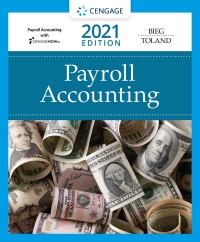

 24
24
Callahan Construction Company initiated operations on January 1, 2016. At that time, Callahan's management used the percentage-of-completion method to account for its contracts. The estimates used indicated that the contracts would generate income equally each year; the projects were 4 years in duration and were 25% complete each year. On January 1, 2019, the company switched to the completed-contract method to better reflect the company's shift in contract length. Contracts are shorter in duration and are not as material in terms of total value. Relevant income information for both methods follows. Callahan is subject to a 40% income tax rate. Assume that Callahan can use the percentage-of-completion method for tax purposes and on the company's tax returns after the change for financial reporting purposes. (Click the icon to view the income information for both methods.) . Read the requirements. Requirement a. Compute the cumulative effect after tax. (For accounts with a $0 balance, make sure to enter "O" in the appropriate cell. Use a minus sign or parentheses for any decreases in income.) Completed- Change in Net Change in Net Cumulative Change in Net Income Contract Method Income Income Year (New Method) Pre-Tax Net of Tax Net of Tax Percentage-of- Completion Method (Old Method) $ 85,000 85,000 85,000 2016 2017 2018 2019 85,000 340,000 Income information Percentage-of- Completion Method (Old Method) Completed- Contract Method Year (New Method) 2016 $ 85,000 $ 0 2017 85,000 0 2018 85,000 0 2019 85,000 340,000 Requirements a. Compute the cumulative effect after tax. b. Prepare the journal entry to record the change in method effective January 1, 2019. c. Prepare the accounting change footnote in the financial statements for the year of the change. Callahan Construction Company initiated operations on January 1, 2016. At that time, Callahan's management used the percentage-of-completion method to account for its contracts. The estimates used indicated that the contracts would generate income equally each year; the projects were 4 years in duration and were 25% complete each year. On January 1, 2019, the company switched to the completed-contract method to better reflect the company's shift in contract length. Contracts are shorter in duration and are not as material in terms of total value. Relevant income information for both methods follows. Callahan is subject to a 40% income tax rate. Assume that Callahan can use the percentage-of-completion method for tax purposes and on the company's tax returns after the change for financial reporting purposes. (Click the icon to view the income information for both methods.) . Read the requirements. Requirement a. Compute the cumulative effect after tax. (For accounts with a $0 balance, make sure to enter "O" in the appropriate cell. Use a minus sign or parentheses for any decreases in income.) Completed- Change in Net Change in Net Cumulative Change in Net Income Contract Method Income Income Year (New Method) Pre-Tax Net of Tax Net of Tax Percentage-of- Completion Method (Old Method) $ 85,000 85,000 85,000 2016 2017 2018 2019 85,000 340,000 Income information Percentage-of- Completion Method (Old Method) Completed- Contract Method Year (New Method) 2016 $ 85,000 $ 0 2017 85,000 0 2018 85,000 0 2019 85,000 340,000 Requirements a. Compute the cumulative effect after tax. b. Prepare the journal entry to record the change in method effective January 1, 2019. c. Prepare the accounting change footnote in the financial statements for the year of the change


 24
24





